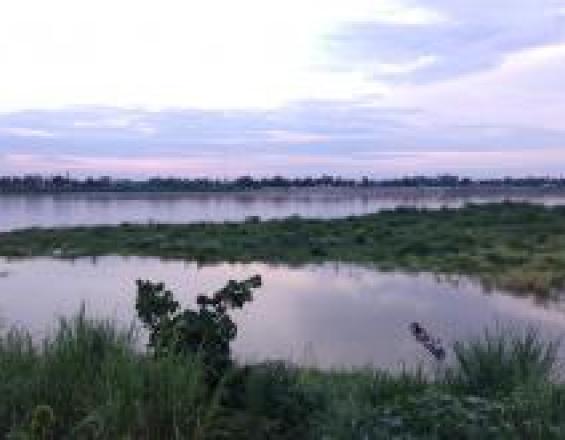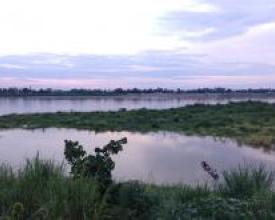Creación y evaluación de zonas protegidas de agua dulce
Solución completa

Zona protegida de agua dulce
Harmony Patricio
Evaluamos la eficacia de las áreas protegidas de agua dulce existentes en la cuenca del río Mekong, en la República Democrática Popular Lao, formando a la población local para que nos ayudara a recopilar datos. También creamos nuevas áreas para proteger a las carpas amenazadas (Probarbus jullieni y P. labeamajor). Organizamos muchos talleres y consultas con las comunidades para que las partes interesadas ayudaran a diseñar las nuevas áreas protegidas.
Última actualización: 02 Oct 2020
5012 Vistas
Contexto
Défis à relever
Disminución de las poblaciones de peces Las comunidades que viven cerca del río Mekong dependen de la pesca para alimentarse y obtener ingresos, pero muchos peces están disminuyendo. Debido al papel central del río en los medios de subsistencia, muchos aldeanos apoyan la conservación. La ley laosiana autoriza a las comunidades a crear zonas protegidas de agua dulce. Por desgracia, muchas comunidades carecen de los conocimientos técnicos o políticos necesarios para evaluar las APA existentes.
Ubicación
Lào
Sudeste Asiático
Procesar
Resumen del proceso
Cada elemento puede ser útil por sí solo, pero su aplicación integrada es esencial. El diálogo con las partes interesadas es esencial cuando se trabaja con comunidades locales, sobre todo cuando el objetivo de conservación es un recurso fundamental para su nutrición y sus medios de vida. El diálogo con las partes interesadas fue lo que aclaró los métodos adecuados para establecer nuevas AMP. La recopilación de datos e información requirió el desarrollo de capacidades y el diálogo. El problema es que no hay suficientes peces, por lo que la solución debe implicar a las partes interesadas, ya que son los principales beneficiarios del recurso y también causan un impacto directo en las especies raras. Si nos limitáramos a decirles que dejaran de capturar estas especies, sin antes entablar un diálogo con las partes interesadas, la solución alcanzada no habría sido posible. Si les permitimos compartir sus puntos de vista sobre el tipo de AAP y las normas sobre anotaciones que les convendrían, tenemos más garantías de que cumplirán la normativa en cuya elaboración han participado.
Bloques de construcción
Talleres con las partes interesadas a lo largo del proceso de planificación
Durante todas las fases de planificación de este proyecto celebramos talleres con las comunidades locales para debatir la creación de AAP, evaluar qué tipo de estructura y normativa les resultaría más eficaz y mejorar sus posibilidades de éxito. Para ello se celebraron varias rondas de reuniones con diversos grupos de las comunidades, como sindicatos de pescadores, sindicatos de mujeres y jefes de aldea.
Factores facilitadores
Establecer relaciones en las primeras fases - Obtener opiniones representativas de la comunidad - Trabajar en el contexto cultural
Lección aprendida
Póngase en contacto con el proveedor de soluciones
Encuestas CAP con la comunidad
Nuestro personal llevó a cabo una encuesta de conocimientos, actitudes y prácticas (CAP) en las comunidades locales para evaluar las perspectivas locales sobre la ecología de los peces, la gestión de los recursos naturales, las fuentes de alimentos y la comprensión actual de la legislación relacionada con estos temas. La encuesta se diseñó para ser realizada en tres ocasiones a lo largo del proyecto a un grupo demográfico diverso, representando una mezcla de edades y géneros, así como a aquellas personas que dependían de diferentes fuentes primarias de sustento. Al observar los cambios en las respuestas, esperamos medir el éxito del proyecto. Durante las encuestas iniciales, la población local demostró un gran conocimiento del comportamiento de los peces Probarbus en peligro de extinción, y también informó de la disminución de esta y otras especies de peces.
Factores facilitadores
Los encuestados se sienten cómodos para hablar con sinceridad y no dejarse influir por otros miembros de su comunidad o por lo que creen que el encuestador quiere oír.
Lección aprendida
A pesar de nuestros esfuerzos por llevar a cabo las encuestas con personas fuera del alcance del resto de la comunidad, el tiempo desbarató nuestros planes. La fuerte lluvia hizo que muchas personas que esperaban a ser encuestadas se agolparan en los edificios donde se realizaban las encuestas.- Es necesario planificar las condiciones variables sobre el terreno de forma que se garantice la privacidad de las partes interesadas mientras son encuestadas.- Es importante desarrollar estrategias que garanticen que se escuchan todas las voces. Un aspecto clave de dicha estrategia es comprender qué miembros de la comunidad pueden ser reacios a hablar y por qué.
Locales de formación sobre la evaluación de la eficacia de la gestión de las AP
Formamos a la población local para que nos ayudara a recopilar datos con el fin de evaluar la eficacia de las AMP existentes para implicarla en la conservación y la cogestión, desarrollar su capacidad técnica y recopilar datos con un presupuesto relativamente pequeño. Nuestros esfuerzos incluyeron formaciones con personal del gobierno y de WWF, y varios talleres comunitarios y sesiones de formación para participantes locales en los pueblos asociados.
Factores facilitadores
Deseo de participación de la población local- Diversas herramientas de enseñanza, incluidos diagramas y prácticas manuales- Supervisión sostenida para garantizar que han aprendido los métodos correctamente y mantienen los protocolos a lo largo del tiempo o en condiciones inesperadas.
Lección aprendida
Las condiciones inesperadas pueden causar confusión sobre cómo proceder si los métodos están diseñados para condiciones específicas- Trabajar con mujeres nos proporcionó técnicos muy detallistas y comprometidos- Las formaciones deben repetirse a menudo varias veces- Se necesita contacto y apoyo constantes para la resolución de problemas.
Impactos
Nuestro trabajo ha repercutido en la población local al desarrollar su capacidad técnica para recopilar datos. Al colaborar con nosotros en la evaluación de las áreas protegidas, la población local ha adquirido una idea tangible de cómo funcionan sus áreas protegidas para la conservación de los peces y la sostenibilidad de las cosechas y los medios de subsistencia. Las comunidades que establecieron nuevas AMP se sintieron muy orgullosas de sus logros colectivos. Al proteger el hábitat de desove y reducir las capturas, nuestro proyecto ayuda a mantener las poblaciones de especies amenazadas y otras de gran valor ecológico y económico. Las especies de agua dulce se enfrentan a una mayor tasa de extinción que las terrestres o marinas. Al proteger la biodiversidad en las AMP tenemos un impacto positivo en los ecosistemas más amenazados del planeta
Beneficiarios
pescadores y miembros de las comunidades cercanas.
Historia
Rompiendo con los roles tradicionales, las mujeres laosianas se unieron a una iniciativa de investigación en el centro de la RDP Lao. Las mujeres recibieron formación para recopilar datos pesqueros con el fin de evaluar la eficacia de los AAP destinados a la conservación de los peces. En trabajos anteriores en varias aldeas habíamos observado que las mujeres eran muy diligentes a la hora de llevar registros del pescado capturado por los hombres y gestionar las ventas en los mercados. El hecho de que se les otorgara un papel formal en la investigación y la gestión de los peces, y de que se reconocieran sus habilidades, las empoderó. La sensación de orgullo por haber adquirido nuevas competencias técnicas y por gestionar la recogida de datos para un proyecto de investigación era palpable. Algunas mujeres dijeron que sentían que ahora tenían una posición mejor y más respeto dentro de la comunidad. También consideraban que habían adquirido más conocimientos sobre la ecología de los peces y se sentían más seguras para hablar en las reuniones de gestión de la comunidad. En las comunidades a las que consultamos para establecer nuevas AMP, en un principio sólo propusimos vedas estacionales, para proteger a los adultos reproductores de dos especies amenazadas durante su periodo de cría. Nos quedamos sorprendidos y encantados cuando las comunidades dijeron que querían que las zonas estuvieran cerradas todo el año. Pensaban que era una forma más eficaz y fácil de gestionar las zonas protegidas, que aumentaría el cumplimiento y reduciría la necesidad de hacer cumplir la ley. En casa del jefe de la aldea, los miembros de la comunidad se reunieron para hablar de los avances en el establecimiento de las AAP y participar en una encuesta sobre los conocimientos, actitudes y prácticas locales relacionados con la gestión de los peces y los recursos naturales. Al término de la encuesta y la reunión, y con el apoyo unánime de la comunidad, el jefe de la aldea firmó el reglamento para formalizar las nuevas AAP. Se sirvió una cena de celebración a base de pato, arroz y diversas variedades de plantas silvestres recolectadas localmente, regada con Lao Hai, una variedad local de vino de arroz fermentado en grandes vasijas de cerámica.
